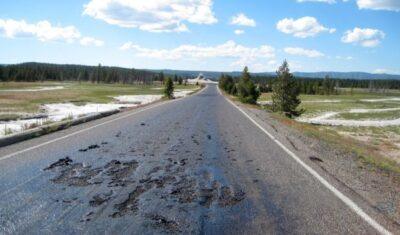
Image source: BillingsGazette.com
Like a scene from a Hollywood summer blockbuster, the roads of Yellowstone National Park are melting from the ancient supervolcano that lies beneath the park.
The geothermal heat from the molten lava caused thick oil to rise to the surface, creating unsafe driving conditions on Firehole Lake Drive.
“It basically turned the asphalt into soup,” the park spokesman, Dan Hottle [1], told USA Today. “It turned the gravel road into oatmeal.”
The 3.3-mile popular scenic road closed for a few days for repairs and was recently reopened. It’s not uncommon to see road problems in Yellowstone due to the underground heat and shifting Earth.
“We see this kind of thing quite a bit,” Hottle said.
Although hot ground temperatures are expected this time of year at Yellowstone, the size of the molten lava under the supervolcano has surprised even geologists.
Last December, scientists released data showing that the magma reservoir under the supervolcano [3] is two-and-a-half times larger than previous estimates, as Off The Grid News reported.They discovered that the cavern is colossal, and stretches for more than 55 miles and contains 240 cubic miles of molten rock that flow under Montana, Idaho, and Wyoming.
“We record earthquakes in and around Yellowstone, and we measure the seismic waves as they travel through the ground,” Dr. Jamie Farrell from the University of Utah told the BBC.
“The waves travel slower through hot and partially molten material… with this, we can measure what’s beneath.”
“To our knowledge there has been nothing mapped of that size before,” he added.
According to the U.S. Geological Survey (USGS) [4], the last time Yellowstone experienced a giant eruption was more than 640,000 years ago — and researchers don’t know when it will erupt again.
But in March, a video of bison stampeding through Yellowstone went viral. Since then, many rumors have spread about the imminent eruption of this ancient volcano. And the same week as the bison stampede, there was a 4.8 earthquake [5] in Yellowstone. It was the largest earthquake to rock the park since 1980.
In spite of the recent bison stampede and earthquake, scientists still think that the risk of Yellowstone having a giant eruption in our lifetime is small.
“The chance of that happening in our lifetimes is exceedingly insignificant,” said Peter Cervelli, a scientist [6] with the Yellowstone Volcano Observatory.
But one thing is for certain: if it did erupt, the results would be devastating. According to the USGS [4]:
Such a giant eruption would have regional effects such as falling ash and short- term (years to decades) changes to global climate. The surrounding states of Montana, Idaho, and Wyoming would be affected, as well as other places in the United States and the world. Such eruptions usually form calderas, broad volcanic depressions created as the ground surface collapses as a result of withdrawal of partially molten rock (magma) below.
How To Prepare For A Volcanic Eruption
While we don’t know whether Yellowstone will erupt anytime soon, there’s nothing wrong with preparing for disaster ahead of time. And if you live close to Yellowstone or another active volcano, it’s even more important for you to plan ahead.
If you haven’t done so already, put together an emergency supply kit. Your emergency kit should include the following:
- First aid kit
- Flashlight and extra batteries
- Food
- Water
- Manual can opener
- Essential medication
- Sturdy shoes
- Respiratory (breathing) protection
- Eye goggles
- Battery-powered radio
Make sure that you have two plans: one to take shelter and another to evacuate. Review these plans and make sure that everyone in your family understands them.
If Yellowstone were to erupt, do you think that the U.S. would be ready? Tell us in the comments section below.
Sign up for Off The Grid News’ weekly email and stay informed about the issues important to you [7]
